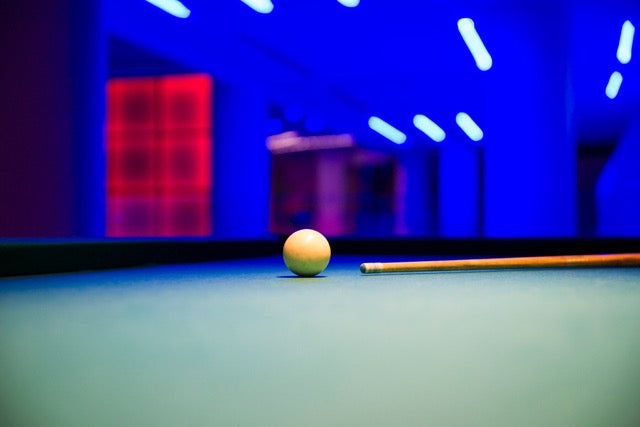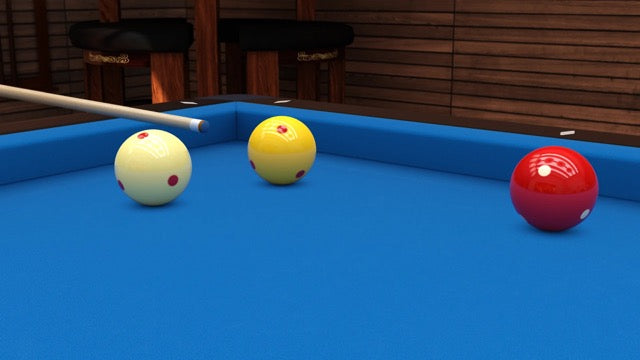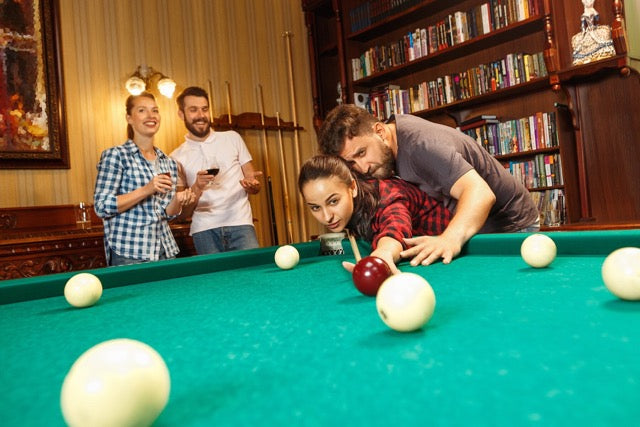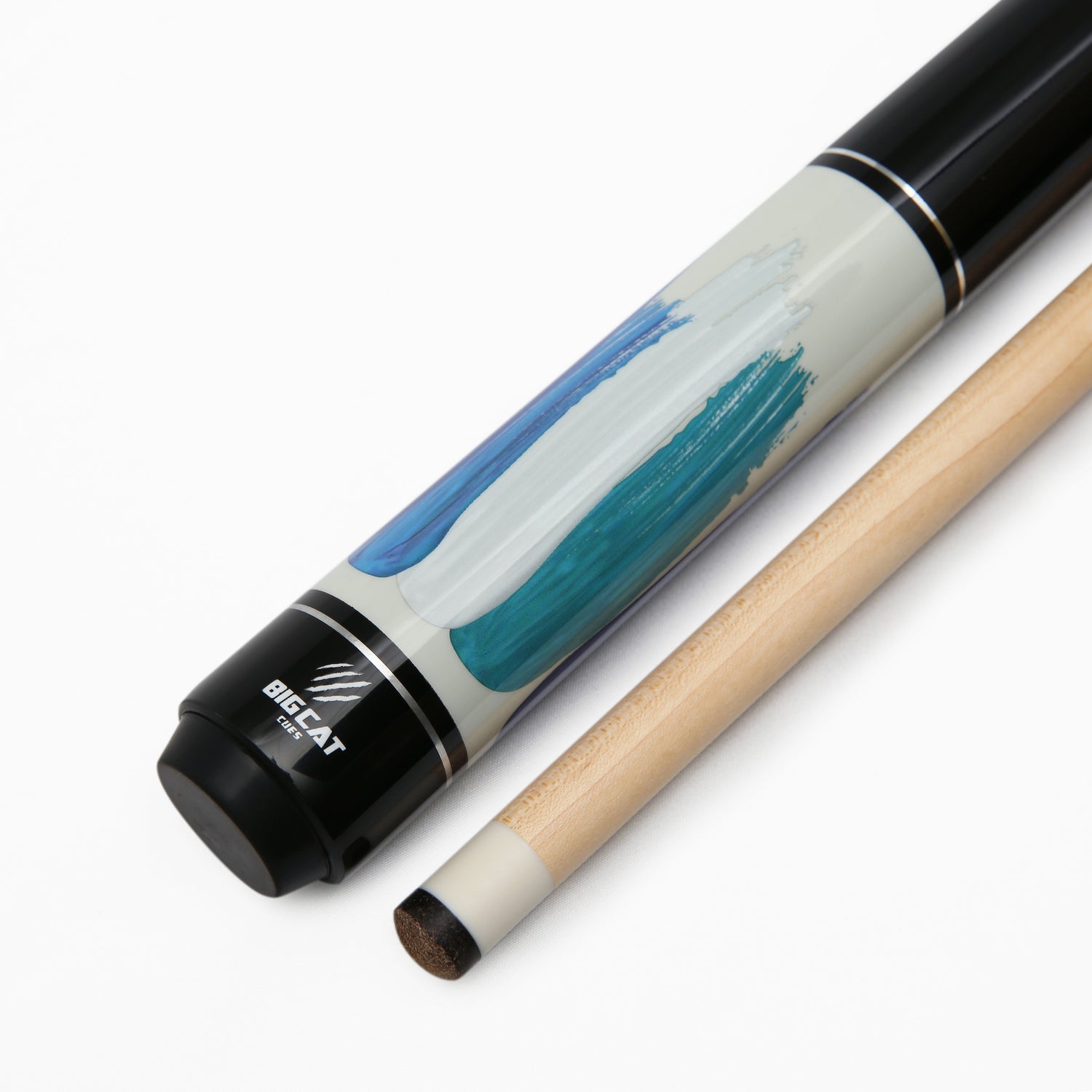
Billiards vs Pool: Key Differences You Need to Know
Key Takeaways
-
Billiards is a family of cue sports played on a pocketless table covered in felt, using three balls. The game emphasizes precision and strategy, with players scoring points by making carom shots (the cue ball contacting both other balls). Learn more about the fundamentals and strategy of billiards below!
-
Pool is a popular cue sport played on a six-pocket table, typically using 16 balls. It involves pocketing balls in specific orders or groups, depending on the game type, such as 8-Ball or 9-Ball. Explore the different types of pool games and their rules in this article!
-
Billiards is played on a pocketless table, while pool tables have six pockets. Billiards tables are typically larger, and their design focuses on precision and rebound angles. Pool tables are smaller and prioritize pocket play for scoring. Explore the unique differences between billiards vs pool!

Billiards vs Pool
Visit Big Cat for diverse cue stick products with affordability, durability, quality, and impressive visual-looking!
What Is Billiards?
Billiards is a family of indoor games played on a special table covered with felt cloth. Players use a cue stick to hit balls around the table. The main goal in most billiard games is to score points by getting balls into pockets located at the edges of the table or by making specific ball contacts.
When we talk about different types of billiard games, you'll commonly encounter pool, which is very popular in many countries. Here is how you can distinguish:
-
In pool, players typically try to sink colored and numbered balls into pockets in a specific order.
-
In snooker, which uses more balls and has different scoring rules, meaning players alternate between hitting red balls and colored balls.
-
In carom billiards, you play on a pocketless table where points are scored by making your ball hit both other balls.

There are many different types of billiard games. Source: Facebook 3 Cushion New Zealand
The essential equipment for playing billiards starts with the table itself, which has a flat, level surface covered in smooth green or blue felt.
A cushioned rail around the edges makes balls bounce back. You'll need a cue stick, a long, tapered wooden or composite rod used to strike the balls.
The balls themselves vary depending on the game. For instance, pool uses a white cue ball to hit colored and numbered balls, while snooker uses a white cue ball, red balls, and different colored balls.
The fundamental elements of gameplay involve several key skills and concepts.
-
Position requires players must think ahead about where the cue ball will end up after each shot to set up their next move.
-
Shot accuracy needs proper aim and control of how hard you hit the ball.
-
Spin and bounce off the cushions or sidespin.
-
Breaking is the opening shot that spreads the racked balls across the table.
What Is Pool?
Pool is a popular type of billiards game played on a felt-covered table with six pockets.
The basic concept involves striking a white cue ball and pocket-colored numbered balls according to specific rules. It's both a casual recreational activity and a competitive sport that tests precision, strategy, and focus.
When it comes to different varieties of pool games, 8-ball is the most popular. It is widely played in bars and homes.
In this game, players compete to pocket either striped or solid-colored balls before legally sinking the black eight ball.
On the other hand, 9-ball is another popular variant where players must hit the lowest numbered ball first and ultimately pocket the nine ball to win. Also, straight pool focuses on scoring points by pocketing any ball on the table, while cutthroat pool requires at least three players to try to eliminate each other's designated balls.

Pool game is one of the billiard game types
The equipment needed for pool games includes:
-
A pool table, which is typically covered in green or blue felt and features rubber cushions along the rails for balls to bounce off. There are many standard pool table sizes, with home tables often measuring 7 or 8 feet in length.
-
A cue stick is usually made of wood or composite materials, with many pool cue joints and tips for striking the ball.
-
A standard set of pool balls includes sixteen balls: one white cue ball and fifteen numbered balls with stripes and solids in different colors.
-
Chalk to prevent the cue tip from slipping.
-
A rack to arrange the balls at the start of the game.
-
A bridge stick to help with hard-to-reach shots.
See more: How To Identify Pool Table Room Size: In-depth Guide
Key Differences Between Billiards and Pool
Understanding the difference between billiards and pool is crucial for anyone interested in cue sports.
When searching for what's the difference between billiards and pool, there are several key differences:
1. Physical Setup
When examining the differences between billiards table vs pool table, the most noticeable factor is that billiards are played on a pocketless table with a flat surface bordered by cushioned rails. The playing area is designed purely for ball rebounds and positioning.

Pocketless table for billiards game. Source: The Cue Cave
Conversely, pool tables feature six pockets, one in each corner and two along the middle of the longer sides.
Looking at billiards vs pool table surfaces, the felt cloth color traditionally differs, too. In particular, billiards often use red or blue felt, while pool tables typically feature green felt.
See more: How To Identify Pool Table Room Size: In-depth Guide
2. Equipment Components
The primary difference between billiards and pool equipment lies in the balls used.
In billiards, players use just three balls (2 7/16 inches in diameter): two white balls (or one white and one yellow) for each player and one red ball. Due to the larger ball size, the game requires more precise control.

Billiards only requires three balls due to their large sizes. Source: Shooterspool
What about how many balls on a pool table?
In contrast, how to rack a pool table depends on different pool games. However, the most common one, 8-ball, requires a set of 16 slightly smaller balls (2 1/4 inches), including a white cue ball and 15 numbered balls divided into solids (1-8) and stripes (9-15).
Moreover, both billiards vs pool use pool sticks, but pool often requires a wider variety of specialized cues for different types of shots.
Check for more details below!
3. Basic Rules and Objectives
In pool vs billiards gameplay, billiards scoring relies on making your cue ball contact both other balls, often called a "carom." Points come from successful ball-to-ball contacts and specific shot combinations.
Pool's objective varies by game type. For example, in 8-ball, players must pocket their assigned group (stripes or solids) before legally sinking the 8-ball. While in 9-ball, balls must be pocketed in numerical order, with the 9-ball being the winner.
4. Gameplay Strategy
The difference between billiards vs pool strategy is significant.
Billiard strategy centers on positioning through cushion rebounds and precise ball control, requiring players to think several moves ahead while maintaining exact ball positions.

Carom billiards. Source: RWTH AACHEN UNIVERSITY University Sports
In pool, the strategy combines pocket shot selection with position play. This means players must plan both where to pocket balls and where the cue ball should stop for the next shot, which is intended to create a different kind of pattern planning and spatial awareness.
5. Professional Competition
Professional billiards competitions often focus on three-cushion billiards, where the cue ball must contact at least three rails before completing a scoring shot.
Yet, professional pool tournaments feature multiple game types, with 9-ball being particularly popular in televised events. The tournament formats, scoring systems, and championship structures differ significantly between the two sports.
Let’s look at the comparison table on what's the difference between billiards and pool:
|
Feature |
Billiards (Carom) |
Pool |
|
Table Type |
Pocketless table with cushioned rails |
Table with six pockets (corners and middle sides) |
|
Table Size |
Varies, often similar to pool tables |
Typically 7, 8, or 9 feet in length |
|
Table Surface |
Often red or blue felt |
Typically green felt |
|
Number of Balls |
3 balls total |
16 balls total |
|
Ball Types |
2 white (or 1 white, 1 yellow) and 1 red |
1 white cue ball, 7 solid colored (1-8), 8 striped (9-15) |
|
Ball Size |
2 7/16 inches diameter |
2 1/4 inches diameter |
|
Basic Objective |
Score points by making the cue ball hit both other balls |
Pocket-specific balls according to game rules |
|
Main Games |
Three-cushion, Straight rail, Balkline |
8-ball, 9-ball, Straight pool, Cutthroat |
|
Scoring System |
Points for successful ball contacts |
Varies by game (winning by pocketing specific balls) |
|
Key Skills |
Cushion play, positioning, precise ball control |
Shot making, position play, pattern planning |
|
Strategy Focus |
Multi-rail shots and ball positioning |
Pocket selection and cue ball control |
|
Professional Format |
Emphasis on three-cushion billiards |
Multiple game types, especially 9-ball |
The Equipment Used In Billiards vs Pool
Although billiards vs pool shares some differences, both games require similar equipment. Let’s check it out:
1. Cue Sticks
Both games use wooden cue sticks, but they have distinct characteristics.
Billiards cues are typically longer (around 58 inches) and heavier (18-21 ounces) than pool cues. They also have a thicker shaft and smaller tip (10-11mm) for precise control.
Pool cues are generally shorter (57 inches) and lighter (17-19 ounces), with a slightly larger tip (12-13mm) for more power-focused shots.
See more: 4 Best Pool Cue For The Money: 2025 Reviews
2. Tables
Billiards tables are notably larger, measuring approximately 10 feet by 5 feet, and feature a distinctive flat surface without pockets. The playing surface is heated to prevent moisture and maintain consistent ball movement.
Pool tables are more compact. They are typically 9 feet by 4.5 feet for tournament play (though home tables can be smaller) and include six pockets: one in each corner and one in the middle of each long side.

Pool tables are smaller, with six holes on either side. Source: Amazon
Both billiards table vs pool table use slate beds covered in specialized cloth, though billiards cloth tends to be faster.
3. Balls
The ball sets differ significantly between the games.
Billiards (specifically carom billiards) uses just three balls: one red ball and two white cue balls (one marked with a spot to distinguish it). Each ball is slightly larger (61.5mm) than pool balls.
Pool uses a set of 16 balls: one white cue ball and 15 numbered balls (1-15), divided into stripes and solids, measuring 57mm in diameter.

8-ball pool game requires 16 balls to play
4. Additional Equipment
Both games share some common accessories like chalk, rests (mechanical bridges), and triangular racks, though pool racks accommodate more balls.
Billiards tables often feature specialized heating systems and require more precise leveling due to the lack of pockets influencing ball movement.
Which One Should You Play?
Billiards vs pool have similarities in the rules and how to play. Yet, there are differences that will need to be considered. So, which game is best suited for your style?
1. Playing Style Considerations
Billiards requires exceptional precision and forward-thinking. Each shot must set up the next move without the benefit of pockets.
You'll need to master techniques like cushion shots, spin control, and position play. Players often describe it as "physical chess" because of the strategic depth involved in planning multiple shots.
Pool offers more immediate gratification and diversity in play styles. While it certainly requires skill, the presence of pockets means you can focus more on shot execution rather than complex positioning. However, the rules of pool games are less complicated.
2. Learning Path and Accessibility
Billiards has a challenging initial learning path. The lack of pockets means even basic shots require more precision, and scoring can be more challenging for beginners. However, some players find this challenge deeply rewarding as they develop their skills.
Yet, pool is generally more approachable for newcomers.
Basic shots are more forgiving, and the clear objective of pocketing balls makes progress easier to understand. This accessibility makes this game more suitable for beginner casual players while still offering depth for professionals.
See more: 8 Best Pool Cues For Advanced Players To Consider For Your Next Game
3. Social and Competitive Aspects
Billiards tends to attract players who enjoy a more focused, contemplative game. It's often played in specialized clubs or formal settings, and matches typically involve longer periods of concentrated play.
On the other hand, pool has a stronger social element. It is widely available in bars, recreation centers, and homes. The shorter game duration and more straightforward ruleset make it ideal for casual gatherings and socializing, making it perfect for home play.

While billiards is more for tournaments, pool is ideal as a social game
Frequently Asked Questions
1. What is the main difference between billiards and pool?
The biggest difference is in the tables and the number of balls used. Billiards (specifically carom billiards) is played on a pocketless table with just three balls, with one red and two white cue balls.
Pool is played on a table with six pockets and uses 16 balls, including a white cue ball and 15 numbered balls. The games also have different objectives: billiards involves making points through balls contacting each other, while pool focuses on pocketing balls in a specific order.
2. Can billiards be played on a pool table?
Yes, while you technically can practice some billiards shots on a pool table, true billiards cannot be properly played on a pool table. The pockets interfere with the rail shots that are essential to billiards gameplay, and the different table dimensions affect shot angles and ball paths. Additionally, pool tables are typically smaller than billiards tables, which changes the dynamics and strategy of the game significantly.
3. What’s the most popular pool game?
8-ball pool is by far the most popular variant of pool worldwide. It's the game most people think of when they think of pool. The rules are simple, players are assigned either stripes or solids and must pocket their assigned balls before legally pocketing the 8-ball to win.
4. Is billiards more difficult than pool?
Yes, most experts consider billiards more challenging to master than pool. The no-pocket rule means every shot must be precisely calculated for both immediate success and position for the next shot. The smaller number of balls actually increases difficulty as there's less room for error in positioning.


